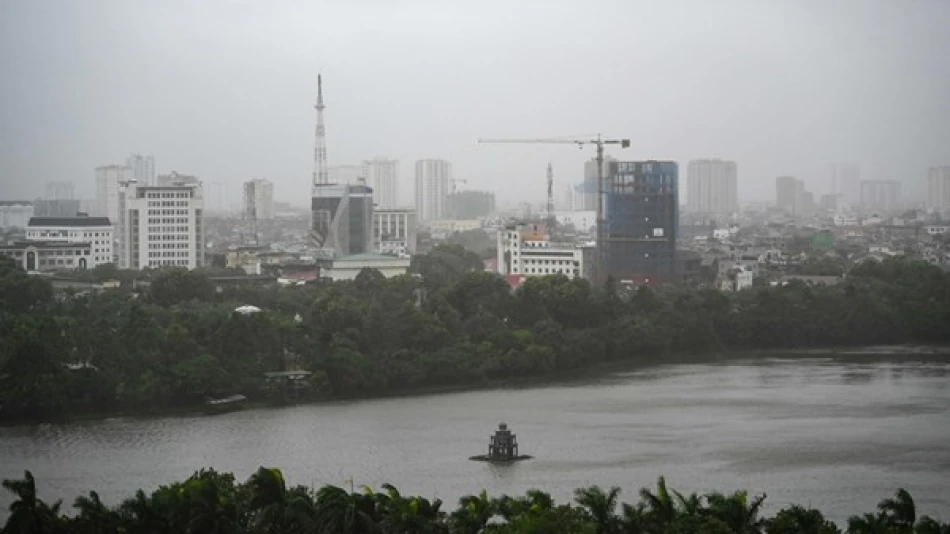
Typhoon 'Kagi' Batters Vietnam's Coastline: Devastating Impacts and Rescue Efforts
Typhoon Kajiki Devastates Vietnam as Climate Change Fuels Rapid Storm Intensification Across Southeast Asia
Vietnam bore the brunt of 2024's most violent storm as Typhoon Kajiki slammed into the country's central coast Monday with winds reaching 133 kilometers per hour, forcing the evacuation of 300,000 residents and highlighting the growing threat of rapidly intensifying tropical cyclones in Southeast Asia. The storm's swift transformation from a weak tropical depression to a devastating typhoon within just two days mirrors last year's deadly Typhoon Yagi, signaling a troubling pattern that could reshape disaster preparedness strategies across the region.
A Storm That Defied Early Predictions
Kajiki's rapid intensification caught many off guard. What began as a modest tropical depression on August 22 exploded into a powerful typhoon in under 48 hours, striking the coastal provinces of Nghe An and Ha Tinh during afternoon hours. Meteorologists confirmed the storm maintained its peak intensity for approximately 20 hours—an unusually long duration that amplified damage potential.
The parallels to 2023's Typhoon Yagi are striking and concerning. Yagi similarly underwent explosive intensification before devastating the region, ultimately killing around 300 people and causing $3.3 billion in economic losses. This pattern of rapid strengthening reflects broader climate trends that are making tropical cyclones more unpredictable and potentially more dangerous.
Massive Mobilization Reveals Regional Preparedness Evolution
Vietnam's response demonstrated how the country has adapted its disaster management following previous catastrophes. Authorities deployed over 16,500 soldiers and more than 100,000 relief workers, while central coastal provinces including Thanh Hoa and Da Nang implemented emergency protocols that shut down shipping operations and closed multiple airports, canceling dozens of flights.
This proactive approach represents a significant shift from past practices, where evacuation orders often came too late. The decision to relocate 300,000 coastal residents before the storm's peak shows Vietnam has learned hard lessons from previous typhoon seasons.
Economic Disruption Spreads Beyond Borders
The storm's economic impact extended well beyond Vietnam's borders. In China's Hainan Island and Guangdong Province, Kajiki disrupted critical shipping lanes and forced the evacuation of 20,000 people. The cross-strait shipping route between Haikou and mainland China—a vital commercial artery—saw approximately 5,000 trucks backed up awaiting passage, illustrating how single weather events can cascade through regional supply chains.
For investors and businesses operating in Southeast Asia, Kajiki underscores the growing importance of climate resilience planning. Companies with manufacturing or logistics operations in the region may need to factor more frequent severe weather disruptions into their operational models.
Thailand Braces as Storm System Continues Westward
Thailand's meteorological authorities have issued heavy rainfall warnings for 35 provinces as Kajiki's remnants track westward. Bangkok, already prone to seasonal flooding, faces potential inundation that could affect the country's economic hub and major international airport.
This westward trajectory highlights how modern typhoons increasingly affect multiple countries, requiring greater regional coordination. Unlike historical storms that might dissipate quickly after landfall, today's more intense systems often maintain destructive potential across vast distances.
The New Normal: Rapid Intensification Becomes Standard
Climate scientists have long warned that warming ocean temperatures would fuel more rapid cyclone intensification, and Kajiki appears to validate these predictions. The storm's quick evolution from depression to typhoon mirrors global trends where storms strengthen faster, leaving less time for preparation and evacuation.
For Southeast Asian governments, this reality demands fundamental changes to early warning systems and emergency protocols. Traditional forecasting models that assume gradual storm development may prove inadequate against systems that can double in strength within 24-48 hours.
The region's vulnerability is compounded by dense coastal populations and critical infrastructure concentrated in typhoon-prone areas. Vietnam's textile manufacturing hubs, Thailand's shipping ports, and China's electronics production facilities all lie within the expanding zone of intense tropical cyclone activity.
Regional Implications for Disaster Preparedness
Kajiki's multi-country impact suggests Southeast Asian nations may benefit from enhanced regional cooperation on typhoon preparedness. Shared early warning systems, coordinated evacuation protocols, and joint disaster response capabilities could help mitigate future storms that increasingly refuse to respect national boundaries.
The storm also raises questions about infrastructure resilience standards across the region. As typhoons grow more intense more quickly, building codes and coastal defenses designed for historical storm patterns may prove insufficient for future climate realities.
 Layla Al Mansoori
Layla Al Mansoori







